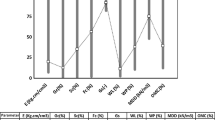Abstract
An essential task in the process of construction is the determination of compaction properties of soils. Many years of laboratory test experience strengthen our belief in the existence of predictive equations that govern the compaction characteristics of soils. An advanced mathematical model developed in this research in order to uncertain the governing equations. An advanced mathematical model developed in this research in order to uncertain the governing equations. Through a comparative study among a Multiple Linear Regression (MLR) model, an Artificial Neural Network (ANN) model, Extreme Learning Machine (ELM) and a Support Vector Machine (SVM) model, the best predicting model was determined. For this purpose, Six hundred and six (606) samples collected and split into a dataset used for training the models and another used for validation of the derived model. 8 neural networks with a varying number of hidden layers and a varying number of nodes in hidden layers were employed. In ELM 1 hidden layer with varying number of units were employed. It was found that the equations derived from the ELM models described the relationship with superiority over multiple regression, ANN and SVM models for Maximum Dry Density and MLR models described the relationship with superiority over ANN, ELM and SVM models for Optimum Moisture Content.












Similar content being viewed by others
References
Ibrahim SF (2013) Baghdad subgrade resilient modulus and liquefaction evaluation for pavement design using load cyclic triaxial strength. J Environ Earth Sci 3(12)
Johnson AW, Sallberg JR (1960) Factors that influence compaction of soils. Bulletin No. 272, Highway Research Board, National Academy of Sciences, Washington, DC
Korfiatis GP, Manikopoulos CN (1982) Correction of maximum dry density and grain size. J Geotech Eng Div ASCE 108(GT9):1171–1176
Olden JD, Jackson DA (2002) Illuminating the “black box”: a randomization approach for understanding variable contributions in Artificial Neural Networks. Ecol Model 154:135–150. https://doi.org/10.1016/S0304-3800(02)00064-9
Omar M, Shanableh A, Basma A et al (2003) Compaction characteristics of granular soils in United Arab Emirates. Geotech Geol Eng 21: 283–295. https://doi.org/10.1023/A:1024927719730
Ring GW, Sallberg JR, Collins WH (1961) Correlation of compaction and classification test data. Bulletin 325, Highway Research Board, pp 55–75
Acknowledgements
This research is part of a comprehensive study to predict the compaction properties of soils from various physical properties through advanced mathematical models. Researchers are working on a similar project for the purpose of prediction of compaction characteristics of fine grains.
Author information
Authors and Affiliations
Corresponding author
Rights and permissions
About this article
Cite this article
Omar, M., Shanableh, A., Arab, M. et al. Advanced Mathematical Models to Predict the Compaction Properties of Coarse-Grained Soils from Various Physical Properties. Geotech Geol Eng 36, 3467–3483 (2018). https://doi.org/10.1007/s10706-018-0547-2
Received:
Accepted:
Published:
Issue Date:
DOI: https://doi.org/10.1007/s10706-018-0547-2




